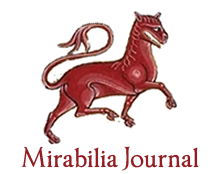Voluntary Abortion − Debate
Leonardo Serafini PENITENTE, Hélio ANGOTTI NETO, Ricardo da COSTA, Sandra Helena PEREIRA
Original title: Debate Sobre o Abortamento Voluntário
Published in
Keywords: Abortion – Bioethics – Public Health.
Multidisciplinary debate on voluntary abortion liberation involving physicians, philosophers, lawyers, psychologists and embryologists.
Waters of Otherness and Unity: the Mediterranean and the Western Currents of Non-Dualist Thought
Leandro BERTONCELLO
Original title: Águas de alteridade e de unidade: o Mediterrâneo e as correntes ocidentais do pensamento não dualista
Published in Intercultural Mediterranean
Keywords: Mediterranean, Non-dualism, Unity of Being, Western philosophy.
Language:
This article analyzes the development of non-dualist thought in the Mediterranean, challenging the traditional view that restricts it to Eastern spiritualities. Based on the region’s dynamics of fragmentation and connectivity, it argues that the search for the unity of Being permeated various Western philosophical traditions, from Parmenides to Ramon Llull. The circulation of ideas in the Mediterranean fostered the formulation of concepts that reject the absolute separation between subject and object, spirit and matter, divine and human. Furthermore, the study examines how modern philosophical historiography marginalized or reinterpreted non-dualist currents in the West, emphasizing dualism as a dominant feature. The reassessment of this intellectual legacy allows for the recognition of the Mediterranean as a space of philosophical synthesis, where unity and multiplicity were reconciled within a distinct tradition. Thus, the article proposes a critical reevaluation that situates Western non-dualism within a broader framework of intellectual history.
Ways of thinking and acting: erudite culture at court and reordering of assistance in the reign of king D. João II (1481-1495) and D. Leonor (1481-1525)
André Costa Aciole da SILVA
Original title: Maneiras de pensar e de agir: a cultura erudita na corte e o reordenamento da assistência no reinado de D. João II (1481-1495) e D. Leonor (1481-1525)
Published in Society and Culture in Portugal
Keywords: Assistance, Culture, Hospitals, Medicine, Portugal.
The theme of assisting those in need of material resources or spiritual support, and especially the sick, has been the focus of intense historiographical production. The following text points out an aspect that contributed to the reordering of assistance in Portugal at the end of the Middle Ages, focusing on the actions promoted by the monarchs of D. João II and his wife D. Leonor. Our objective is to show how the erudite culture in the court, as well as some external influences, helped to guide the creation of the royal hospitals in Lisbon (Hospital of All Saints) and Caldas da Rainha (Hospital Our Lady of Pópulo).
Wet words. Representation of passions and aquatic metaphors in De Noe by Ambrose of Milan
Lidia Raquel MIRANDA
Original title: Palabras mojadas. Representación de las pasiones y metáforas acuáticas en Noé de Ambrosio de Milán
Published in Senses and sensibilities in classical and medieval worlds
Keywords: Ambrose of Milan, Metaphor, Noah, Passions, Water.
De Noe by Ambrose of Milan (ca. 378) reflects on the human condition and the consequences of man's actions in the natural order. The Christian commentator exposes the patriarch’s life, customs and acts since an allegorical interpretation of Scripture and considering him as the prototype of the just and wise man, crossed by passions but who manages to choose the right path. The ark is a symbol of the world, from which it is possible understand the system of analogies on which the text is based, since it is also a representative figure of the body and the person. Thus, the ark is presented as the condition of sinners –unstable, corruptible, and at the mercy of the swings of the soul–, a figure that gives rise to a set of metaphors around water and aquatic issues. We focus on the philological and discursive analysis of these metaphors with the aim of explaining their symbolic projections and their moral reach.
When everything would appear to man as it is – infinite, from Kant to Viola (1781-1983)
Waldir BARRETO
Original title: Quando tudo pareceria ao homem tal como é – infinito, de Kant a Viola (1781-1983)
Published in The World of Tradition
Keywords: Art, Bergson, Infinite, Kant, Sublime, Video, Viola.
This essay proposes a theoretical consideration about the possibility of a transcendental analysis of the aesthetic experience with art according to Kantian criticism and the temporal dimension of Bill Viola’s work, taken from the Bergsonian concept of duration.
When the monster is called Bluebeard
Maria de la Pau JANER
Original title: Quan el monstre es diu Barbablava
Published in
Keywords: Bluebeard, Chamber prohibited, False travel, Perrault, Tales husband killer, The husband monstrous, Transgression.
This paper provides a general overview of one of the figures of sixteenth century Valencian literature, Bernat Català de Valeriola, and his lesser well-known diary, one of the best examples of the Valencian memorialistic works of that period
Why Did People ‘Invent’ Relics in the Roman East Between the Fourth and Sixth Centuries?
Estelle CRONNIER
Published in Pleasure in the Middle Ages
Keywords: Church, Inventions, Politics, Relics, Roman East.
The cult of relics did not exist in the first centuries of the Christian era, but only came into being in the fourth century. After the Peace of the Church and the Christianisation of the Roman Empire, it became a constitutive element of the new religion. However, a very small number of holy graves known to exist and could be pinpointed. This could explain why a series of ‘inventions’ or miraculous discoveries happened in this time – first of all in the Eastern provinces of the Empire –, that is to meet the needs of worship. But relics were not found at just any time or place. A careful examination of the different cases in their historical context gives us a better understanding of this phenomenon.
Woman and eroticism in the Galician-Portuguese troubadour lyric
Pedro Carlos Louzada FONSECA, Márcia Maria de Melo ARAÚJO
Original title: Mulher e erotismo na lírica trovadoresca galego-portuguesa
Published in Mulier aut Femina. Idealism or reality of women in the Middle Ages
Keywords: Cantigas de amigo, Eroticism, Galician-Portuguese troubadour lyric.
It is an approach of the female images reproduced in the cantigas de amigo “Fui eu, madre, lavar meus cabelos” by Johan Soarez Coelho and “Levou s’ aa alva, levou s’ a velida” by Pero Meogo, both outstanding troubadours Galician-Portuguese. In the cantigas de amigo, eroticism appears as the theme of the possibility of satisfaction, of promise, of desire or its negation, and of the closeness of happiness. In this sense, it is intended in this paper to reflect on the recurring images in the lyricism of these minstrels and how ethical elements of loyalty, courage, tenderness are treated by an erotic-cultural aspect that makes the medieval nobility capable of transforming the sufferings of love into beauty, offering in this way a meaning and a suitable value for feeling.
Women and the supreme power in Byzantium (5th-11th centuries). Numismatic approach
José María de FRANCISCO OLMOS
Original title: Las mujeres y el poder supremo en Bizancio, siglos V-XI. Aproximación numismática
Published in Mulier aut Femina. Idealism or reality of women in the Middle Ages
Keywords: 5th-11th centuries, Byzantium, Empresses, Numismatics.
This paper studies the evolution of the role of Byzantine women in relation to the Empire government, with special attention to the numismatic evidence. The analyzed period goes from the beginning of the Empire in the 5th century to the middle of the 11th, with a detailed analysis of those reigns that seem most significant in the evolution of this issue, that is those of Pulcheria, Irene and the sisters Zoë and Theodora, with whom women finally became able to assume the government in their own names, without any shade of fiction, as seen on the previous cases.
Yungang: a Chinese Buddha to the Romans
André BUENO
Original title: Yungang: um Buda Chinês para os Romanos
Published in
Keywords: Ancient China, Buddhism, Buddhist Iconography, Intercultural Dialogue, Roman Empire.
The aim of this paper is to analyze the Akshobhya Buddha statue (in Chinese, Achurulai 阿閦如来), located in the cave 16 in Yungang Complex (Yungang Shiku 雲崗石窟), which is situated in northern China, and is built in 5th century CE. Our proposal is that this statue was sculpted to receive foreigners, especially the Romans, using an in Buddhist iconographic experience that incorporated elements Greco-Roman, Indian and Chinese.






















































































